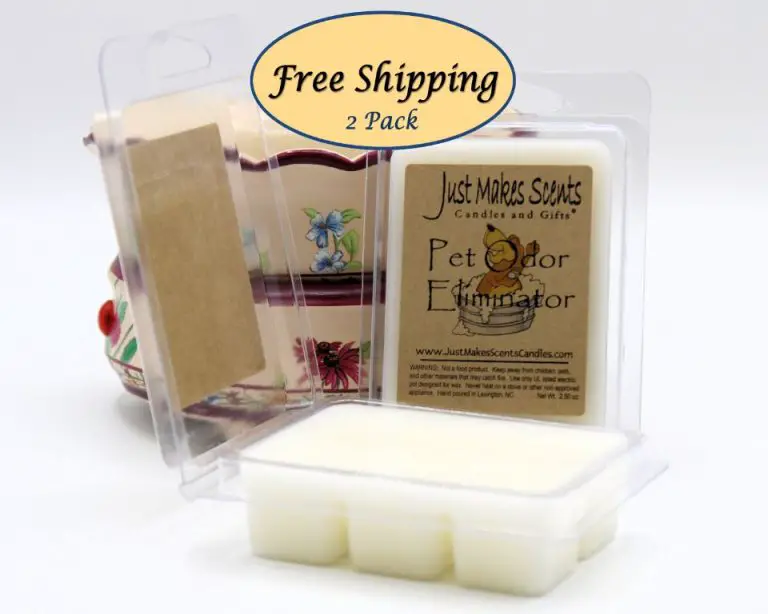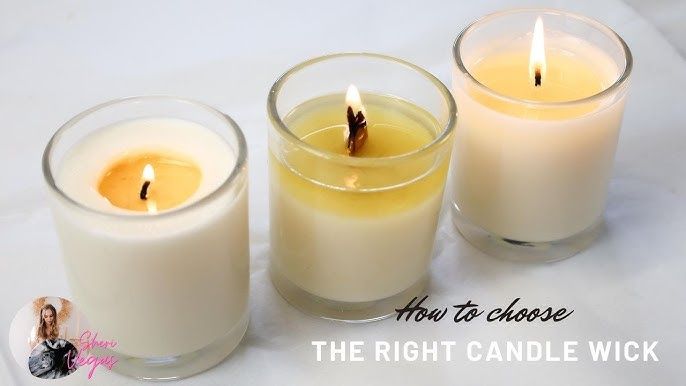What Ingredients Are In A Soy Blend Candle?
Soy blend candles are made from a combination of soy wax and other waxes, typically paraffin wax. They have grown in popularity in recent years as an alternative to traditional paraffin wax candles.
Soy blend candles are often preferred over paraffin candles because they are made from a renewable resource (soybeans), are biodegradable, and burn cleaner. The soy wax allows the candles to hold fragrances better so they often have a stronger scent. The blend with paraffin helps the wax have a smooth texture and makes the candles easier to pour and produce.
Compared to paraffin wax candles, soy blend varieties put off a stronger smell. The scent lasts longer and smells fresh for quite some time. You don’t have to worry about having to re-light this candle often. The soy wax allows the candle to burn slowly and evenly.1
Additionally, soy blend candles are often perceived as more natural and environmentally-friendly while still providing many of the benefits of paraffin wax like high melt point and easy pouring. The soy component allows the candles to burn cleaner and hold scent better than paraffin alone.
Soy Wax
Soy wax is a vegetable wax made from the oil of soybeans. After harvesting, the beans are cleaned, cracked, de-hulled, and rolled into flakes (Source). The oil is then extracted from the flakes and hydrogenated to convert the liquid soybean oil into a solid wax.
Unlike paraffin wax, which is a petroleum byproduct, soy wax is made from a renewable and sustainable plant-based source. Soy wax has a lower melting point than paraffin, so soy candles burn cooler and lasts longer. Soy wax is also biodegradable and non-toxic, making it a more eco-friendly option than paraffin (Source).
Most soy wax used in candlemaking is sourced from American-grown soybeans. The wax is manufactured through controlled hydrogenation to achieve the desired melting point, hardness, and burn properties for candlemaking.
Essential Oils
Essential oils are concentrated plant extracts that are commonly used to scent soy candles. When added to soy wax, essential oils provide a natural aroma and therapeutic benefits. Some of the most popular essential oils used in soy candles include:
Lavender – Known for its calming, relaxing scent. Lavender essential oil can help reduce stress and anxiety (Source 1).
Peppermint – Has an invigorating minty aroma that can boost energy. Peppermint oil also acts as a decongestant (Source 2).
Lemongrass – Features a fresh, citrusy scent. Lemongrass essential oil helps purify the air (Source 1).
Eucalyptus – Has a cooling, minty smell. Eucalyptus oil helps clear sinuses and ease respiratory issues (Source 2).
Chamomile – Features a mild floral aroma that soothes and calms. Chamomile essential oil can aid sleep (Source 1).
Tea Tree – Known for its medicinal smell. Tea tree oil helps treat skin conditions and respiratory ailments (Source 2).
Cedarwood – Has a warm, woody scent that reduces stress. Cedarwood essential oil also helps repel insects (Source 1).
Overall, essential oils not only provide pleasant scents for soy candles, but also offer various health and wellness benefits. Many essential oils have properties that can help people relax, breathe easier, and more when inhaled aromatically from a lit soy candle.
Natural Dyes
Soy blend candles can be colored using natural dyes extracted from plants, fruits, vegetables, and even insects. Some common natural dye sources for soy candles include:
Turmeric – The root of the turmeric plant produces a vibrant yellow color. Turmeric has been used for centuries in India and Asia as a dye for clothing. It infuses soy wax with a golden yellow hue.
Blueberries – Blueberries contain anthocyanin pigments that produce a range of blue and purple shades. Mashed blueberries can be strained to extract the juice for dyeing soy wax a bluish-purple color. According to Candlemakinghelp.com.au, blueberries give a lovely soft purple in soy wax.
Spinach and Nettles – The leaves of spinach and stinging nettles produce a soft green color when steeped or boiled to extract the chlorophyll. This plant-based green dye has been used for centuries to color fabrics and yarns.
Annatto Seeds – Annatto seeds from the achiote tree are a popular natural dye source in Latin America. They impart a bright orange or yellow color depending on the concentration used. Annatto gives candles a warm, sunny glow.
Cochineal Insects – Cochineal is a natural red dye derived from insects. Though not vegetarian, it produces an unparalleled range of reds, pinks, and burgundies. A little cochineal dye goes a long way when coloring candles.
Other natural dye sources include beets, red cabbage, paprika, madder root, marigold flowers, and more. With some experimentation, candle makers can create an appealing palette from all natural ingredients.
Wicks
The wick is a crucial component of soy candles. Its purpose is to draw wax into the flame in order to sustain combustion. Wicks are made from materials like paper, cotton, wood, and hemp. The type of wick chosen depends on factors like the wax being used, the diameter of the candle, and the desired characteristics of the flame.
Some common wick types used in soy blend candles include:
- Square braided cotton wicks – These wicks have a flat braid and are ideal for container candles. They promote an even burn and medium flame height.
- Zinc or lead core wicks – Zinc core wicks help anchor the wick and provide rigidity, making them well-suited for pillars and votives. Lead core wicks burn hotter.
- Wooden wicks – Wooden wicks crackle when lit, providing ambiance. They work well in soy wax, producing a bright flame.
- Eco wicks – Eco wicks are made from natural fibers like hemp and have a reduced carbon footprint. They burn cleanly.
The wick thickness should match the diameter of the candle vessel. Thicker candles require thicker wicks so the wax can liquefy properly. Testing different wicks to achieve the desired burn is key. How to Choose a Wick for Soy Candles – The Sojourn Company
Additives
Additives are ingredients that can be added to soy wax to enhance certain properties of the finished candle. Some common additives used in soy candles include:
Vybar – This is a proprietary additive made from hydrogenated soybean oil. It helps increase the hardness and opacity of soy wax, which can improve burn time and scent throw. Vybar makes the wax more rigid so it holds scent oils better. Typical usage is 3-6% of the wax weight (Source: https://www.candlemakingsupplies.net/the-purpose-behind-using-wax-additives).
UV inhibitors – These additives help protect against fading of dyes or scent due to UV exposure. Common types are benzotriazolyl dodecyl p-cresol and hydroxybenzophenone. They absorb UV light to prevent degradation (Source: https://lonestarcandlesupply.com/candle-waxes-and-additives-guide/).
Stearic acid – This is a natural saturated fatty acid. It increases hardness and opacity, and improves scent throw. Typical usage is 1-3% (Source: https://www.candlemakingsupplies.net/wax-additives-everything-candle-makers-need-to-know).
Making Soy Candles
Making soy candles involves melting soy wax flakes, adding fragrance and dye, and pouring the wax into containers with wicks. The basic equipment needed includes:
- A double boiler or makeshift double boiler to melt the wax gently
- Soy wax flakes
- Dye and fragrance oils
- Wicks
- Candle containers like jars or tins
- Thermometer to monitor wax temperature
- Spoon for mixing and pouring
A common method is to create a double boiler by placing a few inches of water in a pot on the stove. Place a glass, metal, or ceramic container with the soy wax flakes inside the water bath. Heat the water slowly until the wax melts completely. Remove from heat and add dye and fragrance as desired. Attach wicks to the bottom of containers, then carefully pour the wax into the containers. Allow to fully cool and solidify before trimming wicks and using the finished soy candles. Proper preparation, pouring temperatures, cooling, and curing are vital for high quality soy candles.
Source: How to Make a Soy Candle
Benefits
Soy wax candles offer several benefits compared to traditional paraffin wax candles. First, soy wax is made from soybeans, a renewable and sustainable crop. Paraffin wax, on the other hand, is made from petroleum, a non-renewable fossil fuel. Producing and burning soy wax candles is more environmentally-friendly than paraffin candles.
Second, soy wax produces very little soot when burned, whereas paraffin wax produces more soot that can dirty walls and surfaces over time. The cleaner burn of soy wax makes it better for indoor use.
Third, soy wax is biodegradable and non-toxic if ingested. Paraffin wax is made from petroleum and can release small amounts of toxins like benzene and toluene when burned. Soy wax does not release these carcinogens and is safer for health.
Finally, soy wax holds scent very well since it has a lower melting point than paraffin. This allows soy candles to fill a space effectively with aroma and provide aromatherapy benefits. The fragrance also lasts longer in soy wax compared to paraffin.[1]
In summary, the renewable nature, cleaner burn, and excellent scent throw make soy wax a better choice than paraffin for candle-making and aromatherapy.
Drawbacks of Soy Blend Candles
While soy blend candles have become popular for their natural ingredients and eco-friendly reputation, there are some potential drawbacks to consider:
Soy wax tends to have a lower melting point than paraffin wax, which can lead to faster burn times. This means you may go through soy candles more quickly. According to joetiehome.com, “While soy wax can hold fragrances, it might not always have the same strong scent throw as paraffin candles.”
The natural colors used in soy candles can also fade or discolor over time. Synthetic dyes used in paraffin candles tend to maintain their vibrancy longer.
Soy wax is generally more expensive than paraffin wax. The increased costs come from the higher price of soybean oil compared to crude oil. This means soy candles often retail for higher prices.
There is some debate over whether soy wax is more environmentally friendly than paraffin wax. While soy is a renewable resource, some argue that the resources needed to grow and process soybeans negate some of these advantages. More research is needed to fully understand the environmental impact.
Overall, soy candles can be a great option but may not be ideal for every purpose. Consider your specific needs in terms of fragrance, burn time, color, and budget when choosing between soy blend and paraffin wax candles.
Conclusion
In summary, soy blend candles are a popular candle option made from natural ingredients like soy wax, essential oils, and plant-based dyes. They offer benefits over paraffin candles including being better for the environment, cleaner burning, and avoiding unwanted chemicals. Soy candles burn slower and cooler than paraffin, produce less soot, and have excellent scent throw. The natural ingredients make them biodegradable and non-toxic. For those looking for an eco-friendly, clean burning candle option that also provides great fragrance, soy blend candles are an excellent choice. They provide an alternative to conventional candles without sacrificing performance.





